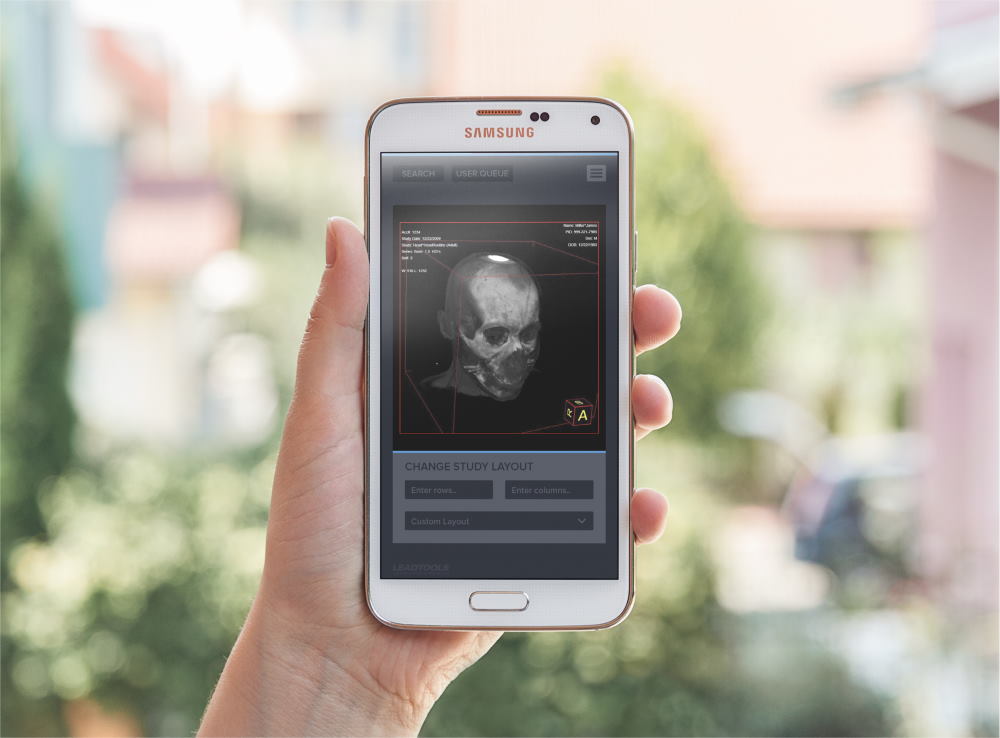Leadtools.Medical3D.Client Introduction
Summary
The Leadtools.Medical3D.Client SDK provides the support needed for server-side 3D rendering and viewing a series of two-dimensional medical images in a three-dimensional space. The LEADTOOLS Medical 3D SDK simplifies the reconstruction techniques used to create 3D visual representations. The class library offers various mathematical algorithms to generate volumetric (3D) data using a stack of image slices. Support is provided for generating many alternate views of the original data using the various 3D reconstruction techniques (e.g., MPR, VRT, MIP, etc.).
Leadtools.Medical3D.Client allows the user to access the graphics card of the server in order to render 3D volumes.
The Problem
3D rendering requires a high-end machine with a powerful graphics card. It is not practical to use high-end machines with powerful graphics cards for each user viewing 3D rendered volumes.
The Solution
Leadtools.Medical3D.Client provides the architecture or framework to leverage the server's computing power to do the heavy-lifting. As a result, even low-end machines, tablets, smart phones, older machines and other mobile devices, with any HTML5 supported browser can view and manipulate 3D volumes.

The toolkit allows rendering different volume types with options including planes, clipping, scaling, thresholding, and color inversion.
The 3D engine works across multiple graphics card providers, such as Nvidia, AMD, Intel, etc. It can also fall back to be rendered using purely the CPU in case the current hardware does not meet the minimum requirements. For more information, refer to LEADTOOLS Medical Web Viewer Minimum/Recommended Requirements.
A three-dimensional view is easier to analyze than the component two-dimensional images. Users can render the object in multiple ways and can select from a wide range of tools that make it easier to view, handle and manipulate 3D objects. With 3D reconstruction, anatomical details (which are difficult to evaluate using 2D axial slices alone), can be visualized. Some example scenarios where the various 3D reconstruction techniques would be useful include:
- Using Maximum Intensity Projection (MIP), a developer can create an application for physicians to more quickly and reliably identify pulmonary nodules.
- Multi-planar Reconstruction (MPR) is regularly used for examining images of the spine to view the intervertebral discs, which are difficult to see in axial images. The position of one vertebrae relative to others is easier to see in a 3D view than in axial images.
- The 3D Volume Reconstruction Technique (VRT), with support for clipping planes, can be used to remove obstructive anatomy from the 3D view. With VRT, you can add transparency to the view, allowing bones to be displayed as semi-transparent to transparent, for better views of the otherwise-concealed anatomy.
LEADTOOLS Medical 3D .NET Class Library offers programmers the ability to create 3D applications quickly and without having to rely on an advanced knowledge of the 3D field. Developers can add 3D support to their applications with minimal lines of source code. As a result, the class library can be used effectively by both beginner and advanced developers.
LEADTOOLS support of reconstruction in orthogonal planes allows developers the option to choose the optimal plane to better display the anatomical structure of interest. Examining volumetric data improves the speed of interpretation and recognition and greatly decreases exam evaluation time.
For very large input objects, a quality and speed trade off is available. The 3D toolkit will internally determine the trade off. For example, if you have a very large 3D object, LEADTOOLS will lower the quality of the 3D object while rotating. When the user releases the mouse (stops rotating the object), the object will switch back to the higher quality rendering.
The toolkit ships with a Medical Web Viewer solution. This is a complete application with source code for you to customize.
Some examples of common applications that use the LEADTOOLS Medical 3D SDK:
- 3D web applications
- 3D image processing applications
- 3D editing tools, such as window level, threshold, color inversion, slab, scale, etc.
- Generic 3D applications
Key Features
The following features are included in the LEADTOOLS Medical 3D toolkit:
- Both software and hardware rendering engines are supported.
-
Object rendering using 3 different types of volume rendering techniques:
- MIP - Maximum Intensity Projection
- VRT - Volume Rendering Technique
- MPR - Multiplanar Reformations
- The ability to change the volume projection method
- Compatibility checker utility that examines the available video card and compares it to hardware minimum requirements, and switches to software rendering if your current hardware does not meet the requirement
- Memory efficient loading and saving utilizing the video card
- Save and load objects as cache objects for faster loading.
- An orientation cube that can be located dynamically
-
Manipulating the 3D object with the following actions:
- Window level
- Pan
- Rotate
- Move plane
- Scale
- Clipping plane feature which allows parts of the 3D volume to be clipped.
- A cross-hair feature for the different plane views.
- The ability to load any image format of the 150+ file formats supported by LEADTOOLS.
- The ability to customize the look of the 3D project by changing the color of the boundaries, the boundary box, the intersection line, and the background color.
- The ability to invert the volume's colors.
See Also
Reference
Getting Started (Guide to Example Programs)
